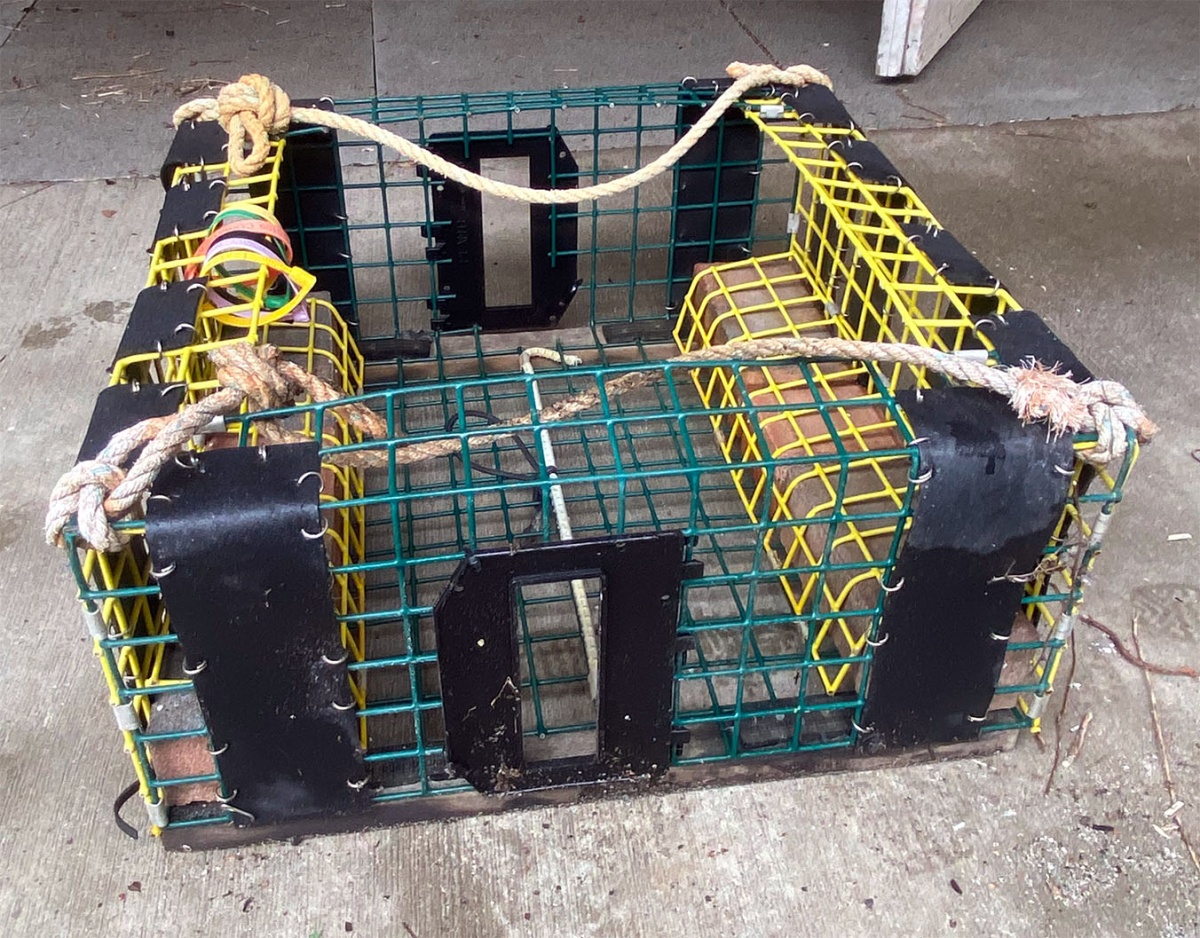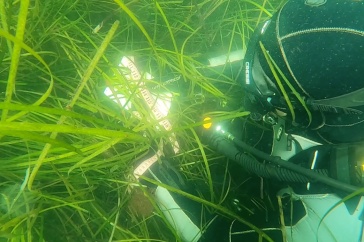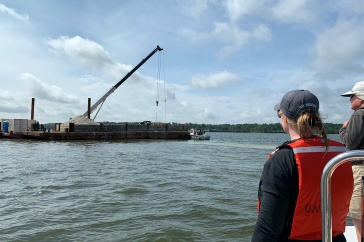Research Goals:
Help make the channeled whelk (Busycotypus canaliculatus) fisheries industry more sustainable by:
- Modifying and standardizing whelk fishing traps with escape vents (not currently required), thus providing a way for whelk under the legal size to escape the traps and to reduce the handling required to remove the smaller whelk from catches—ultimately reducing possible injury and/or death to them.
- Finding an alternative, locally sourced bait option to the industry preferred female horseshoe crab, especially considering the importance of horseshoe crabs to the development and testing of critically needed vaccines and other medical applications.
About Channeled Whelk:
Size and description: Channeled whelks are predatory sea snails with large (up to 8 inches in length) pear-shaped shells. Read more
The shells typically have deep channels between the whorls and range in color from gray to light tan, often with darker brown or red banding.
Range and preferred habitat: The current native range extends from Cape Cod, MA to Florida, as well as into the Gulf of Mexico. Read more
This range overlaps with that of other commercially important whelk, including the knobbed whelk and the lightning whelk. The preferred habitat of channeled whelk is shallow water, including bays, beaches and estuaries.
Diet and predators: Preferred food are bivalves, including oysters, clams and mussels. Common predators are blue crabs and sea turtles.
Maturity and lifespan: Female channeled whelk reach sexual maturity at 9-10 years of age, whereas sexual maturity of male channeled whelk is slightly less. Read more
Because of the age it takes channeled whelk to reproduce, whelk fisheries can go through booms and busts. Whelks can live up to 40 years.
Channeled Whelk Fisheries Information:
Where channeled whelk fisheries exist: Nearly every state from Massachusetts to North Carolina has a commercial whelk fishing industry, however, the regulation of the fishery is different in each state.
Industry value: In Massachusetts, the channeled whelk fishery has topped out at just under 2 million pounds per year for several years now (down from more than 3 million pounds 10 years earlier). Read more
However, the value of channeled whelk has risen in the past several years, buoyed by demand for whelk meat in Europe, particularly the United Kingdom, and parts of Asia (Japan, Vietnam and Korea), to as much as $5 per pound—although recent costs have dropped to about $3.50 per pound. As a result, the value of Massachusetts’ annual channeled whelk haul has been worth upwards of $5 million.
While lobster and scallops tend to get much of the attention as the region’s most popular—not to mention the most valuable—shellfish, a close third is likely something you haven’t seen in your local grocery store very often, if at all: the channeled whelk. That’s because international demand, as well as the shrinking of other regional fisheries like lobster, has diminished channeled whelk fisheries in its native habitat—the Atlantic seaboard from Massachusetts down to Florida—resulting in stricter size and trap limits and, in some states, the temporary closing of fisheries. Fortunately, collaborative research led by UNH scientists and alumni aims to make the industry more sustainable and result in the resurgence of the species, as well as preserve horseshoe crabs, which are often used as whelk bait and are already at risk due to their unique blue blood that is prized by the biomedical industry.
Elizabeth Fairchild, a research associate professor in the department of biological sciences, and Shelley Edmundson ’16G, executive director of the Martha’s Vineyard Fishermen’s Preservation Trust, are leading the research, which is supported by a grant from the National Oceanic and Atmospheric Administration (NOAA) Fisheries’ Saltonstall-Kennedy Program. Along with co-PIs Win Watson, professor emeritus, and Steve Jury ’99G, as well as Kennedy McGrath ’25, Mary Kate Munley ’21, ’23G, Megan Molinari ’21, Massachusetts whelk fishermen and representatives from multiple public and private partners, Fairchild and Edmundson are addressing two key industry issues: the use of traps that don’t allow for sublegal (under the legal size) whelk to escape and the common practice of baiting whelk with chopped up horseshoe crab.
Modifying Channeled Whelk Traps
Working out of the UNH Coastal Marine Lab (CML) in New Castle, N.H., the team has been testing modified whelk traps with escape vents and bait recipes that use little to no horseshoe crab for the past two years. This whelk fishing season, which is from April to December in Massachusetts, they will begin working with local fishermen to determine if modified traps result in less sorting of sublegal whelk and if new bait recipes work as well as—or better than—the horseshoe crab bait.
The scientists have been testing modified whelk traps with escape vents, looking for a design that retains the greatest number of legal-sized whelks and lets out the most sublegal-sized whelks and that is also cost-effective for fishermen to do on their own. As part of their coursework, students in the Undergraduate Ocean Research Project (TECH 797) came up with and trialed a variety of modifications to find designs that are easy to install.
“Some whelk fishermen already modify their traps with escape vents,” explained Fairchild, a scientist with the NH Agricultural Experiment Station. “The Massachusetts Division of Marine Fisheries wants to see an escape vent added, so it’s only a matter of time before they mandate the change and a configuration that fishermen will need to use.”
With the modifications they’ve tested in the lab, the team hopes to bridge the gap between the fishermen and the resource management agencies to find something that’s effective and installable by the former and that meets the goals of the latter.
For McGrath, a dual major in marine, estuarine and freshwater biology and sustainability, working on this research allowed her to gain experience both in the lab and the field.
“I learned a lot about the research process and made a lot of connections,” added McGrath. “And it’s because of my involvement in this research that I plan to pursue my master’s degree, and it has piqued my interest in working with fisheries in some way as part of my career.”
Testing New Channeled Whelk Bait
On the bait side, the team is seeking an alternative to horseshoe crab, which are an ecologically important species as a key food source of migratory birds up and down the Eastern seaboard and a scientifically critical species used in the production of vaccines and other medicines due to the unique toxin-identifying quality of horseshoe crab blood. However, whelk and eel fishermen have used horseshoe crab as a preferred bait source for years and an alternative will need to meet several criteria to become widely used.
“Whelk fishermen all have unique recipes that they use for bait, however, the common denominator in all these is horseshoe crab, particularly female horseshoe crab,” said Fairchild. “So we need new bait recipes that can be made using no or low-cost materials, like seafood waste, that won’t cost more than what they are already using and—most importantly—that are as effective in attracting channeled whelk into the traps.”
Channeled whelk don’t normally eat horseshoe crab in the wild—they commonly predate on bivalves like oysters and clams—so it’s a bit of a mystery why it works so well as a bait source. At the Coastal Marine Lab, the UNH team has tested dozens of recipes, trying different combinations of everything from poultry byproduct meal and clam processing byproduct to invasive green crabs and surf clams that wash up on the beaches.
“Once we came up with our winning recipe consisting of clam bellies and green crab–held together by a binder—we tested its preservation, how it could be stored frozen and then thawed for use,” added Fairchild. “Now we’re distributing them to local fishermen, who will trial them this season in a few of their traps to compare them to the horseshoe crab-based recipes they normally use.”
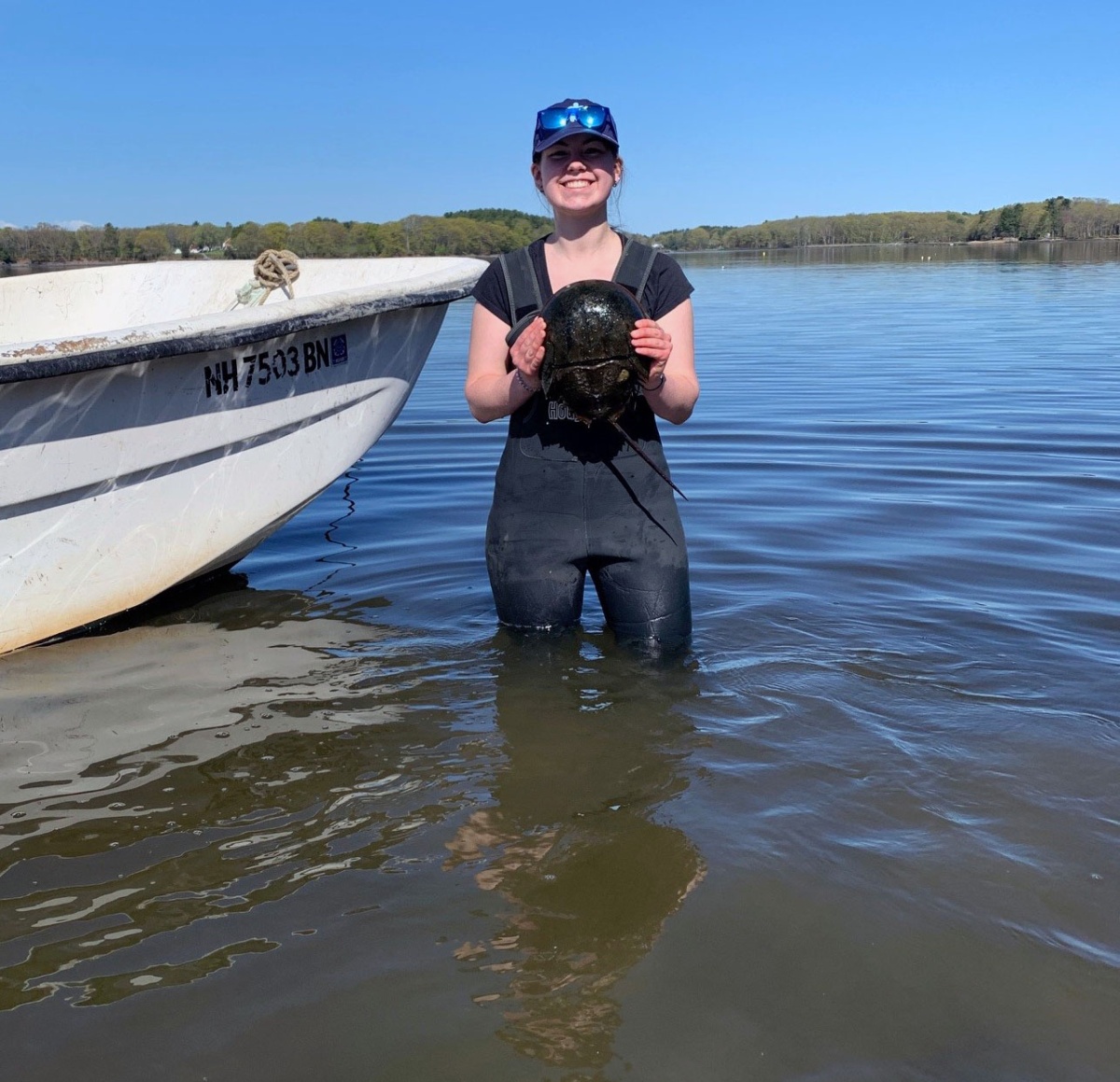
Researcher Mary Kate Munley holds up a horseshoe crab found in New Hampshire’s Great Bay Estuary.
Munley, who has a bachelor’s degree in marine, estuarine, and freshwater biology and a master’s in marine biology from UNH, began working with channeled whelk in the summer of 2020. That year, she and Molinari started researching alternative baits for whelk fishing. When she began her master’s degree program, Munley continued with the whelk research she helped launch the previous year.
“I have really enjoyed researching channeled whelks and alternative baits in part because of the awesome team of people working on this project but also because this project is really the tale of two fisheries—channeled whelk and horseshoe crabs,” said Munley. “There are a lot of things to consider when thinking about the sustainability of baits and these conversations are becoming more and more common among various fisheries.”
According to Edmundson, with the growing potential for future regulations to decrease or eliminate the harvest of horseshoe crabs, the pressure to find an alternative and effective bait is critical.
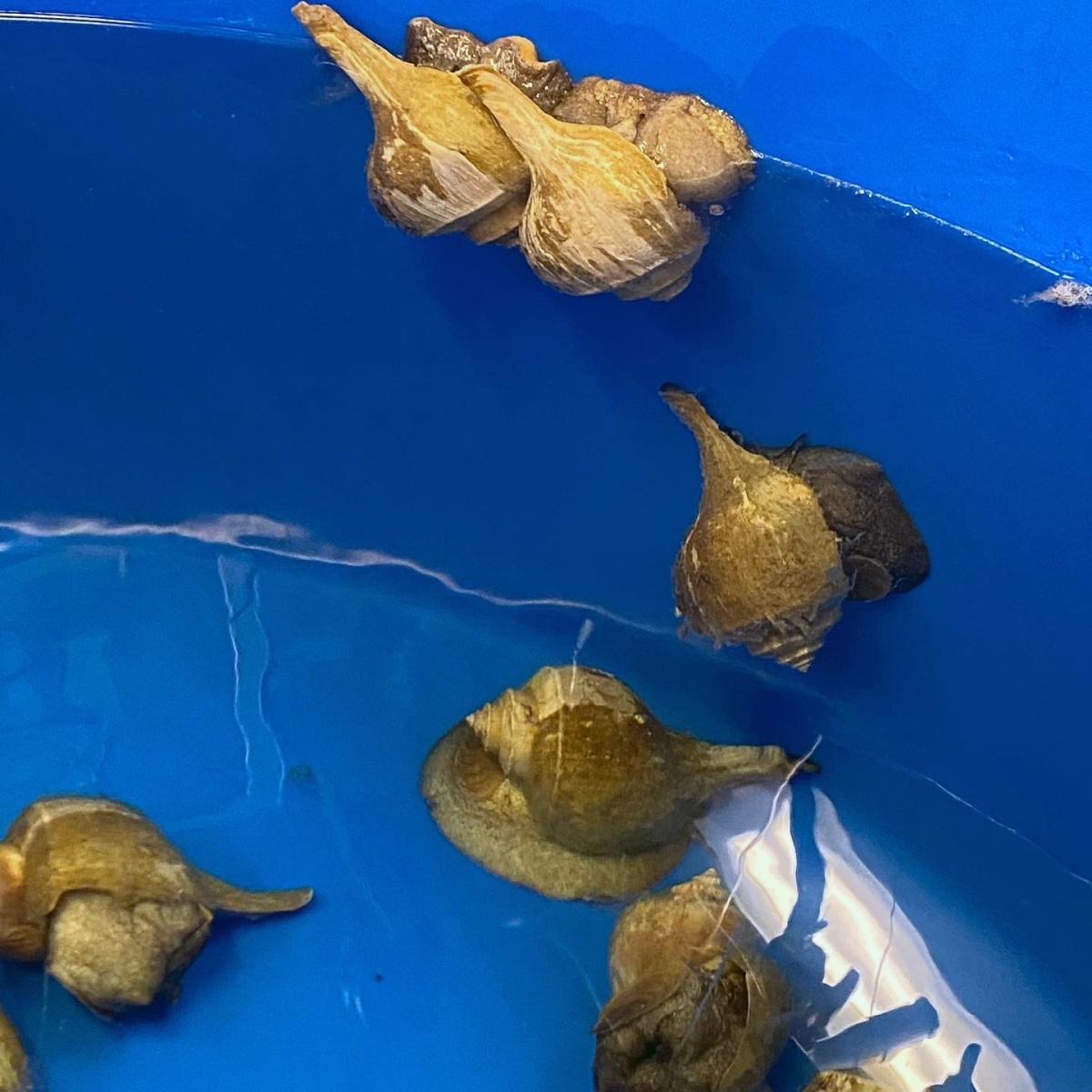
Legal-sized whelk climb the sides of a tank at UNH’s Coastal Marine Lab in Newcastle, NH.
“It could be the difference in this fishery existing or disappearing,” Edmundson added.
This research is supported by funding from the National Oceanic and Atmospheric Administration (NOAA) Fisheries’ Saltonstall-Kennedy Program. Grant title: Sustainable innovations for the channeled whelk fishery: trap modifications and alternative bait.
Collaborating partners:
- Massachusetts Division of Marine Fisheries
- Normandeau Associates Inc. (NH)
- Portsmouth Brewery (NH)
- Cape Cod Commercial Fisheries Alliance (MA)
- Tisbury, Mass., Shellfish Dept
- Atlantic Cape Fisheries Inc (MA)
- Trident Biosystems Inc (MA)
- Virgin Oyster Company LLC (NH)
-
Written By:
Nicholas Gosling '06 | COLSA/NH Agricultural Experiment Station | nicholas.gosling@unh.edu



















































